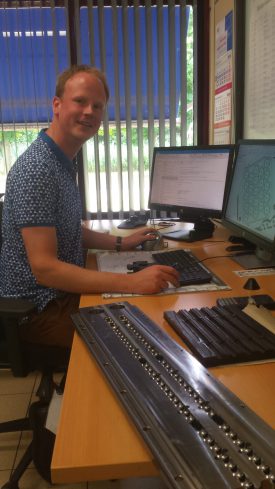Demen Hartman designs moulds
8 June 2018

Demen Hartman has been working as Mould Engineer at RIS Rubber for one and a half years. Demen, who comes from Zutphen, is responsible for the design and delivery of moulds. “The great thing about RIS Rubber is that you have a direct influence on the entire production process and you see the result.”
After his education in Industrial Design (HTS) at Saxion and a job at a metalworking company, Demen (36) opted to join RIS Rubber in 2017. He is involved in the development, realisation and delivery of 30 to 40 moulds annually. His motivation? “Creating a mould for a moulded rubber product that the customer is happy with. In fact, I see producing the right mould design for a product as a game.”
Contributing ideas on the shop floor
Demen takes the rubber mixture, size and number of products and the choice of press into account when investigating the options for a mould. “I do, of course, have an eye for design, but I look primarily at the manufacturability and cost efficiency of the product, along with durability.” User-friendliness during ‘unloading’ of the moulded rubber product is also an aspect to be taken into consideration. “Thanks to the short lines in our factory, I hear what the operators have to deal with. I can take that into account when designing the mould and use clever cutouts or technical solutions.”
Coordination with internal and external business contacts
In any case, Demen coordinates a great deal with clients, steel suppliers, mould manufacturers and with his colleagues on the shop floor. “That makes the work very varied”, the Mould Engineer tells us. “Inside the company, I collaborate a lot with our Technical Manager, QESH Manager and our branch in Bulgaria and, outside the company, I have a lot of contact with our suppliers. That is how you maintain a good relationship with them and get to know what is going on.”
Drawing, calculating and simulating in 3D
Demen spends a lot of his time working with the software program SolidWorks. He translates the digital 2D or 3D models for moulded rubber products he receives into the best possible mould, with all the details, in a 3D drawing. “I calculate and simulate whether and how the rubber product can be realised in a mould, how many cavities we can create or whether modifications are needed in the design. Once the mould and any modifications to the product have been approved, our mould manufacturer will be given instructions to start on its production. When the mould comes in, we check it and make samples and then production can really begin. And I can get started on the next mould.”
Would you like to stay informed of developments within RIS Rubber? You can subscribe to the newsletter at the bottom of the website.

